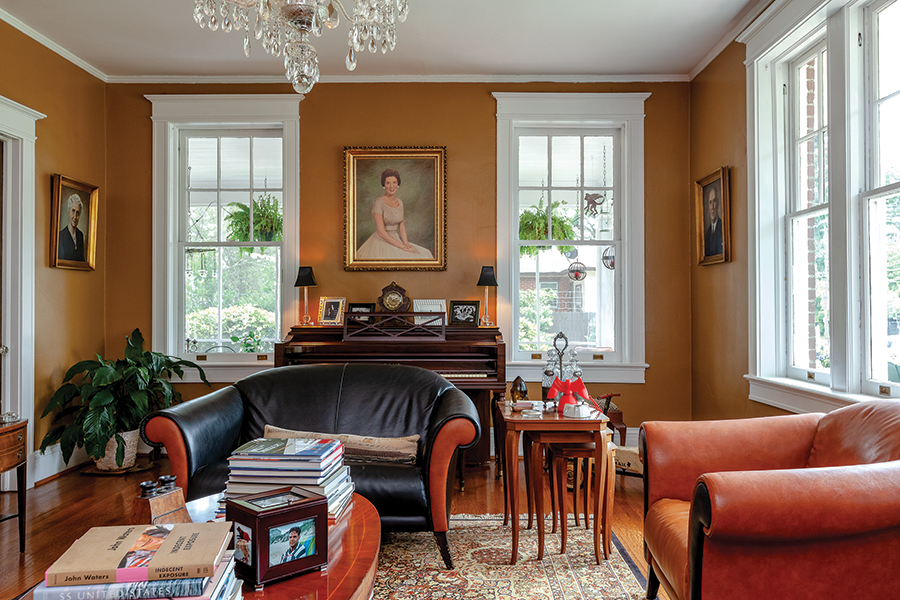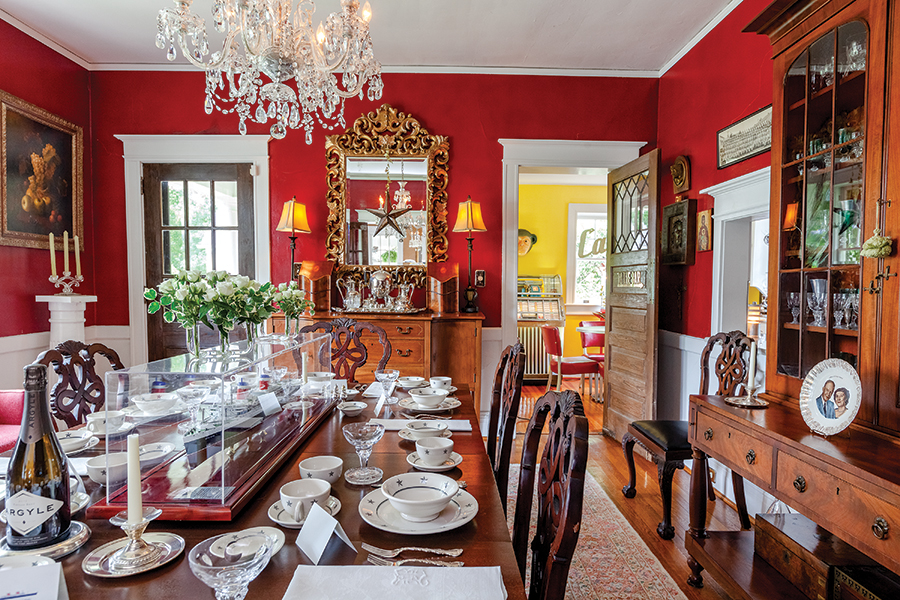Fantasy Island
Local designer Terry Allred brings a tropical flair to an iconic North Carolina beach destination
By Nancy Oakley • Photographs by Andrew Sherman
Vacation, all I ever wanted/Vacation, had to get away . . .” The Go-Gos’ high-pitched chorus of their jaunty 1982 pop hit, “Vacation” rolls around in your mind, if not on the car stereo, as you accelerate with abandon down I-40 toward the beach. Good-bye alarm clock! Good-bye over-air conditioned office with blinding fluorescent lights! Good-bye deadlines! Good-bye broiling Battleground Avenue, clogged honking traffic and the acrid smell of tar! You’re going on vacation! Happy! Happy! Joy! Joy! You can’t wait to get your “toes in the water, ass in the sand,” as another travelin’ troubadour, Zac Brown puts it. Your happy place of choice? The Blockade Runner Beach Resort in Wrightsville Beach.
Impossible not to notice before you even set foot inside the door is a colorful sculpture that takes up the entire front window — a wire frame filled with foam flowers, as it turns out — resembling a sea anemone, the handiwork of interior designer Terry Allred. She understands all too well that for the generations of North Carolinians who have regularly vacationed there, the Blockade Runner is an institution, their “own special place,” to borrow from yet another song, “Bali Hai.” So why not create a similar paradise? “Wrightsville Beach is an island. Let’s make them think they’ve come to an island, a really funky island. A fun island,” she recalls suggesting to the hotel’s owners, Bill Baggett and his sister Mary Baggett Martin, when the décor was due for an upgrade.
The tropical fantasy envelops you as you enter the lobby, where, covering the floor, a bright blue mural by Winston-Salem artist Angelina Taddeucci recalls the blue holes in the Bahamas, though Allred says her inspiration were the overwater bungalows so popular in Polynesian resorts. Overhead, a ripple of aqua-colored, stretchy fabric spans the ceiling — waves, as it were; the far wall, original to the hotel, is also painted bright blue and mounted with various kinds of fish (a vestige of a prior renovation, Allred notes); wooden slats replicating a boardwalk punctuate other walls, another foam flower sculpture in the shape of a seahorse is suspended from the ceiling. “I wanted people to feel like they were walking on water,” Allred explains. “When you walk in, you’re supposed to be absorbing water. There’s water everywhere.” Even in the elevator where a single drop seems to splash off the walls. “Why do you come to the beach? You come for the water, right?”

She and her husband, John, came to the beach 26 years ago. Gate City born and bred, Allred had built a successful design business in her hometown in the 1980s with a high-end consignment store named — what else? — Terry Allred. “It was on North Elm Street where Fishers Grille is,” the designer remembers (she would later relocate it to West Market). “I loved to do vignettes. I’m a designer! C’mon!” she says. The tableaux were her creative outlet, since 98 percent of her clientele were other designers. “Why would I be a stupid idiot and compete with people who were coming in and buying from me all the time?” she posits, adding that occasionally she would hire her compatriots to help with the store, if for nothing else than the camaraderie. “My customers were my life!” she says wistfully.
She was not, therefore “a happy trooper” on that day in 1991 when John Allred announced that his job as an engineer for Wilmington Machinery was taking the two to the Port City. With a heavy heart, Terry Allred the designer sold Terry Allred the store, before she and John embarked for the coast.
But as she notes, Greensboro and Wilmington have long been inextricably linked, and it was a Greensboro connection who made the Allreds’ transition to Wilmington a little easier. “Jane Moffitt [now Jane Moffitt Beeker, owner of JM Designs] was a really, really great customer of mine. Incredible customer,” Allred says. She goes on to explain that she’d helped Moffitt with some installations at the Wilmington community of Landfall, which in the early ’90s was smaller than it is today, “maybe 300 people,” Allred estimates. Being new in town, it was a good place for the couple to start out and meet people, and where Allred could establish her professional reputation. She maintained ties with the Triad, buying antiques for Henredon Furniture’s 11,000 square-foot showroom at High Point Market, and ultimately for Ralph Lauren, which was using Henredon furniture in its galleries nationwide. She and John would eventually move to a house “on the prettiest, cleanest creek on the Intracoastal,” with a “gorgeous” yard they loved to work in, but Allred kept her connections to Landfall, doing interiors for some of its residents. One of them introduced her to the woman who would play a huge part in the designer’s life and career, Blockade Runner’s Mary Baggett Martin.
The hotel had been sold to a developer who had plans to convert the lodging into a condominium development. But before it was inked, the deal fell through, leaving the Baggetts with a hotel that suddenly had no advance bookings. Mary desperately needed to refresh the rooms. Which is how, in October of 2006, Allred became Blockade Runner’s in-house interior designer.

“Mary and I hit it off,” Allred says, recalling how the two went to the High Point Market that October, and later, a show in Atlanta. Her new gig was unique in many respects. “This is a family-owned hotel. This is not Marriott — Marriott tells you what to buy,” Allred offers. She was responsible for selecting everything, down to the tiniest detail. “I was picking toilet paper, salt and pepper shakers . . . nothing came into that hotel that I didn’t put my hands on,” Allred says. Initially, each of the hotel’s 150 rooms had its own unique design. “We would buy throws for the beds, pillows for the beds. We can’t have the same tissue holder for every bathroom, if every room’s different,” Allred says. Housekeeping would often get confused as to which throws belonged in which rooms. And, as she would discover over the course of 12 years, a hotel designer’s work is constantly in progress. For one, it takes months for the furnishings ordered in bulk at Market to arrive in containers. Since the Blockade Runner is almost always fully rented, new furnishings and accents have to be implemented in piecemeal fashion. Guests often rearrange pieces designated for specific spaces. “That doesn’t happen in residential [projects],” Allred notes. Then there’s the wear and tear, requiring most lodgings to refresh their interiors every five years or so. But a beach hotel? “It’s unmerciful,” says Allred, citing the sand and unrelenting humidity.
And yet, for all of the challenges, she was having fun. Allred’s eyes light up at the latest redesign as she scrolls through her iPhone flashing photographs of pillows purchased at Market, some with a Mexican folkloric vibe consisting of a rough weave of deep blue thread on a cream background (“Is this not fun?”); others in bright florals seen in Rifle Paper Company’s stationery, all the rage among the younger set (“Is that not the funnest thing?”). She pauses at another image of flooring in a floral design similar to Moroccan tile (“It’s vinyl; isn’t it cool?”) and another image of a bar that appears to be studded with beachcombers’ finds. (“It’s for the lobby, from Phillips Collection. I thought it looked like quartz and pebbles, see?”).
She had Taddeucci paint big splashy murals of palm fronds and blue coral on the walls of the dining areas, used teak furniture and bright colors for the upholstery. Outside, the landscaped lawn shows more evidence of Allred’s ingenuity: an Easter Island head here (you’re on an island, remember?), a fountain there (Allred laughs about the time she accidentally fell into it), elegant hammocks where one can laze and gaze at the roiling Atlantic; across from the pool area, a set of bright blue wicker pod chairs resembling dolphin fins. Nearby stands an accent wall, its bricks painted in glossy red hues — meant to reflect and amplify the sun’s setting rays beaming from the opposite direction.


Allred credits Mary’s generosity for letting her creative spirit run loose. “Mary spoiled me,” she says of their many showroom jaunts over the years. “She’s taught me a lot. She leaves no stone unturned.” When Allred’s muse strikes and she immediately wants to purchase items that catch her eye, it is Mary who pulls in the reins with a gentle, “Are you sure about that?” or “Let’s go look some more.” Allred has persuaded her friend and employer to rethink things, too, coaxing her away from 150 unique rooms and offering seven distinct floors, instead, the idea being that each visit to the Blockade Runner can be different from the last. On a nautical-themed floor lined with porthole mirrors, sailing enthusiasts will appreciate the sailcloth shower curtains, not to mention the view of watercraft cruising the sound. There is a Rifle floor, using the aforementioned accents of the Rifle Paper Company, and Allred’s favorite, a Bohemian floor whose design was inspired by an elegant dresser she calls “Emma.”
It was love at first sight when she spotted the piece at Market. “I sat down on the floor in front of Emma. And I said, ‘I’m doing a floor with this dresser.’” She likes to think her creative impulsivity has rubbed off. When, at another showroom Mary and younger Brother Ben Baggett gasped in unison at the sight of an enormous Lucite Guildmaster table supported by an enormous driftwood base, Allred immediately ordered the piece, despite Ben’s questioning where in the hotel it would go. Her response? “What difference does it make? “We’ll find a home for something that takes your breath away.” That, after all, part of creating an escape for vacationers. The table, as it happens, now has a place of pride in the stunning, water-themed lobby.
Another pearl of wisdom Allred hopes she has imparted to Mary is the importance of establishing consistent relationships with vendors. She has particular praise for High Point–based Phillips Collection, “because they’re so easy, they’ll do anything for you,” Allred says. For the same reason, she speaks admiringly of BELFOR, the property restoration company that stepped in after the Blockade Runner was saturated with water during Hurricane Florence last fall. “They were fabulous,” Allred says, mentioning that BELFOR had to rebuild the entire balcony section of the hotel, whose roof was ripped off during the storm. Allred was “back in the saddle” in the storm’s wake, going to the High Point and Atlanta shows to purchase furniture, art and accessories and overseeing all the myriad moving parts integral to the hotel’s refurbishment. She says BELFOR was particularly helpful with to replacing carpets, flooring or wallpaper. “They do it. They get it for me, which cuts out some of my hassle.” Having lived through 17 hurricanes, she is all too familiar with the hassle of recovery — the demand for contractors and inspections alone — that many inland dwellers simply do not understand.

But Terry and John Allred will always understand what it means to be waterlogged, even though they themselves are once again inland dwellers. The pull of home was just too strong. They sold their house on the Intracoastal Waterway exactly one week before Florence struck. “I told my husband we should have bought lottery tickets that week,” Allred quips, as she stands before another Taddeucci mural consisting of green leaves on a black background. It is a bold statement in their high-rise, as is the expansive view of downtown Greensboro.
“We love our new life,” Allred sighs contentedly, mentioning the nearby restaurants, Carolina Theater, Triad Stage and the live music from the N.C. Folk Festival readily available from their perch. “I can sit right here, have a glass of wine and watch it all!” the designer enthuses. She likes to walk in Fisher Park, and come winter, make snow angels in City Center Park. “We’re not the beach people we used to be,” she reflects. In fact, she and John have turned their gaze to the west. For when they’re not enjoying the Gate City’s downtown scene, the Allreds take delight in the cool mountain breezes of Meadows of Dan, Virginia, where they frequently socialize with an enclave of fellow Greensborians, visit wineries such as Chateau Morrisette and Villa Appalaccia, dine at the posh mountaintop resort, Primland, and work in a new garden — this one rich in the red clay they’ve missed all these years.
The couple chanced upon a small condominium community while visiting another Baggett family property, Meadows of Dan Campground that includes some log cabins, which, yes, Allred refurbished for her dear friend Mary. The Baggetts, she says, “are family.” And though she officially retired from her post at the Blockade Runner, Allred was still overseeing the post-Forence design work and putting some finishing touches on the lobby — oversized wicker fan chairs, metal palm trees — for its grand unveiling last month before the start of high season. She’ll likely return in October when the property celebrates its 55th anniversary, lending her special magic to the decorations and festivities as she has for every holiday — Thanksgiving, Christmas, Fourth of July — making the hotel a happy place for all who enter its dreamlike watery world. Then she’ll head west again to where she is happiest: “digging in the dirt . . . and visiting wineries.” OH
By the time you read this, Nancy Oakley will be kickin’ back, Zac Brown–style.









































